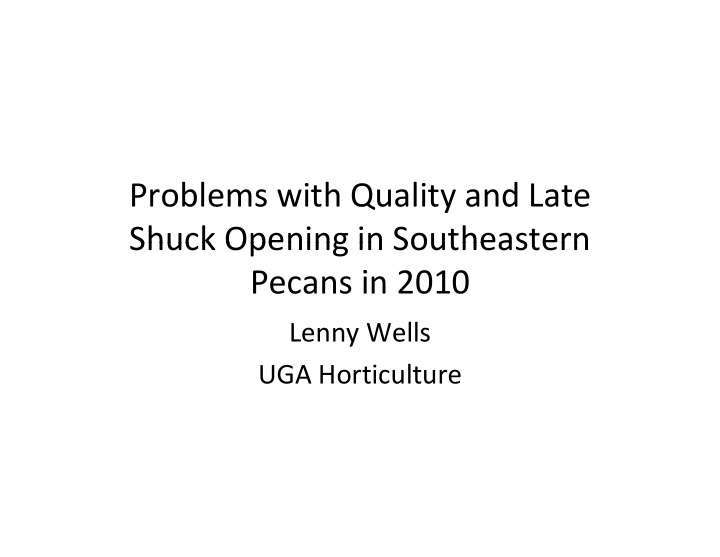



Problems with Quality and Late Shuck Opening in Southeastern Shuck Opening in Southeastern Pecans in 2010 Lenny Wells UGA Horticulture UGA Horticulture
Early 2010 Pecan Crop Predictions for Georgia f G i Littlepage Littlepage Pape Pape Alabama Alabama NPSA NPSA 78 million 85 million 75 million 90 million
2010 Crop Maturity and D Development Issues l I • Cool Spring Temperatures Cool Spring Temperatures “ The temperature effect on date of nut maturity is indirect in that springtime temperatures influence the starting date of fruit development.” Darrell Sparks UGA Horticulture UGA Horticulture “ Cool early season temperatures result in a pronounced dela in pollen shed b t a minor dela in recepti it delay in pollen shed, but a minor delay in receptivity, so so chosen pollen shed –receptivity patterns may not match any more in a year with cool early season temperatures.” Tommy Thompson USDA pecan breeder,
Average Maximum Temperature March h 80 80 70 F) 60 erature ( 50 2010 2009 2009 x. Tempe 40 2008 30 2007 2007 Max 20 10 0 Ft Valley Cordele Albany Tifton Vidalia
Green immature catkins with no evidence of anther dehiscence suggest that Stuart is a few days from pollen shed. • Because many female flowers on adjacent flowers on adjacent Desirable trees are already receptive, they cannot be pollinated by Stuart, because they will no longer b th ill l be receptive when Stuart Rough, glistening fully pollen is shed . developed stigma indicating receptivity of indicating receptivity of ‘Desirable’ flower is near peak. Bill Goff
Pollination Pollination No Pollination Self-Pollination Sparks
Effect of Self ‐ Pollination ‐‐‐ Marquard, 1988 d Self Self Cross Cross Pollination Pollination Weight Weight 5.4g 5 4g 6 5g** 6.5g Volume 7.4 ml 8.3ml** 3.6% NS % Pops 11.7% Self Pollination results in: 17% l 17% less nut wt t t 11% smaller volume
Cool Spring Cool Spring • Cool spring temperatures indirectly delayed • Cool spring temperatures indirectly delayed crop maturity as a result of the delay in budbreak budbreak • Cool spring temperatures reduced pollination of ‘Desirable’ by ‘Stuart’ in some locations of Desirable by Stuart in some locations (and potentially other cultivars), leading to more fruit abortion and lower quality more fruit abortion and lower quality • Use more than one pollinator!
2010 Crop Maturity Issues 2010 Crop Maturity Issues • Cool Spring Temperatures • Cool Spring Temperatures • Extreme Prolonged Heat
Average Maximum Temperature June 1 ‐ September 15 b 96 96 94 92 90 2010 88 2009 2009 86 2008 84 2007 2007 82 82 80 78 8 76 Ft Valley Cordele Albany Tifton Vidalia
Pecans, Heat, and Water Pecans, Heat, and Water • Pecans have a very efficient water transport Pecans have a very efficient water transport system • Developed ability to avoid stomatal closure Developed ability to avoid stomatal closure under high temps with adequate water • Can tolerate temperatures of 106.5 with good Can tolerate temperatures of 106.5 with good soil moisture • Pecans are very inefficient users of water Pecans are very inefficient users of water • Require large amounts of water to support optimal growth and fruit production optimal growth and fruit production
• High daytime temperatures are not a serious • High daytime temperatures are not a serious limiting factor to pecan production UNLESS soil moisture is inadequate soil moisture is inadequate • SE irrigation systems are designed to be supplemental to rainfall supplemental to rainfall • Under prolonged heat and inadequate soil moisture, pecans will suffer i ill ff
2010 Crop Maturity Issues 2010 Crop Maturity Issues • Cool Spring Temperatures • Cool Spring Temperatures • Extreme Prolonged Heat • Late Season Drought S h
Water Deficit June 1 ‐ September 15 b 5 3 1 1 ) ficit (in) ‐ 1 2010 ‐ 3 3 ater Def 2009 2009 ‐ 5 2008 ‐ 7 2007 2007 Wa ‐ 9 ‐ 11 ‐ 13 Ft Valley Cordele Albany Tifton Vidalia
Evapotranspiration June 1 ‐ September 15 b 24 24 23 22 2010 in) 2009 2009 ET (i 21 2008 20 2007 2007 19 18 Ft Valley Cordele Albany Tifton Vidalia
Tree Water Status 2010 (psi) 120 otential ( 100 80 Water Po 60 40 Stem W 20 20 0 0 0 0 0 0 0 0 0 0 0 0 0 0 0 1 1 1 1 1 1 1 1 1 1 1 1 1 1 0 0 0 0 0 0 0 0 0 0 0 0 0 0 2 2 2 2 2 2 2 2 2 2 2 2 2 2 2 2 2 2 2 2 2 2 2 2 2 2 2 2 / / / / / / / / / / / / / / / / / / / / / / / / / / / / 4 1 8 5 2 9 6 3 0 6 3 0 7 3 / 1 1 2 / / 1 2 3 / 1 2 2 / 6 7 7 8 9 / / / / / / / / / 6 6 6 7 7 7 8 8 8 Date Evap Pan Tensiometer Dry
Nut Nut Drought Induced Drought Induced Yield Yield Retention Nut Drop (# nuts (lbs/tree) (%) beneath canopy) (July 20) (Aug. 13) Evap Pan p 61a 22.6a 59a Tensiometer 65a 27.8a 48ab Dry 60a 122.8b 30b
Summary Summary • Cool spring temperatures indirectly delayed nut maturity and directly affected pollination of certain cultivar combinations, which led to fruit abortion • Prolonged heat combined with inadequate Prolonged heat combined with inadequate soil moisture and high ET reduced photosynthesis, leading to poor quality, small photosynthesis, leading to poor quality, small nut size, low volume, and nut abortion
Recommend
More recommend